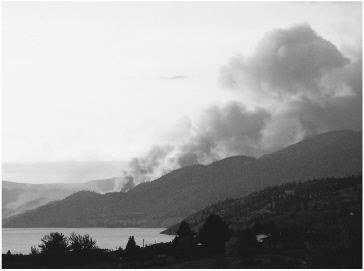focus  Firestorms
Firestorms
The fire that raged across Okanagan Mountain in 2003 was what forest ecologists would term a classic high-intensity, stand-destroying fire. Started by a lightning strike on August 16, the fire quickly moved over the hillside, fanned by constant southerly winds. Thick stands of timber, dried through a long, hot summer, were destroyed as the inferno roared through the treetops. When the fire was finally put out by an army of firefighters and cool autumn rains in late September, it had consumed more than 250 square kilometres of forest and 239 homes on the southern edge of Kelowna. Although this was an extreme example, such fires have become more common in the last century, and not just because the climate is warming.
Evidence from tree rings and historical sources suggest that before the late 1800s, many of these dry forests were subjected to frequent, low-intensity fires set by indigenous people. Set in the cool days of autumn or spring, these fires burned low on the forest floor, killing small trees, shrubs, and dry grass but leaving large, live, older trees to create an open, park-like forest. Ponderosa pines and Douglas-firs are well adapted to these cooler fires; their thick bark protects them from ground fire, and the big trees actually benefit from the regular clearing of smaller plants that compete for water. The habitat created by these fires was ideal for the local people—food plants such as balsamroot, bitterroot, and spring beauty were more common; deer and elk grazed on the abundant grass; and villages were protected from more serious fires.
In the late 1800s, this practice of regularly burning the forest was abruptly stopped as the indigenous people were forced onto reserves and their culture was severely disrupted. Small trees and shrubs grew quickly, turning the open woodlands into thick forests, a pattern exacerbated by the selective logging of large trees and overt fire suppression in the 1900s. These small trees provide abundant fuel that can easily carry ground fires into the crowns of the large trees. Compounded by the climatic change to longer, hotter, drier summers, the scene is now set for more catastrophic firestorms.

Okanagan Mountain fire, August 2003
Prescribed burns are being set more frequently by forest managers to alleviate the problem, but in many areas there is simply too much fuel in the forests to safely do this. Careful removal of lower branches, small trees, and shrubs must be done mechanically before fire can be used to complete the job. These projects can be expensive, but they cost only a fraction of the amount spent on fighting a major forest fire. Public concerns about air quality during prescribed burns and fears about runaway fires must also be addressed, but the greater fear of seeing whole communities razed by wildfire may allow land managers to reintroduce fire as an important ecological tool, as indigenous fire-keepers have done for centuries.